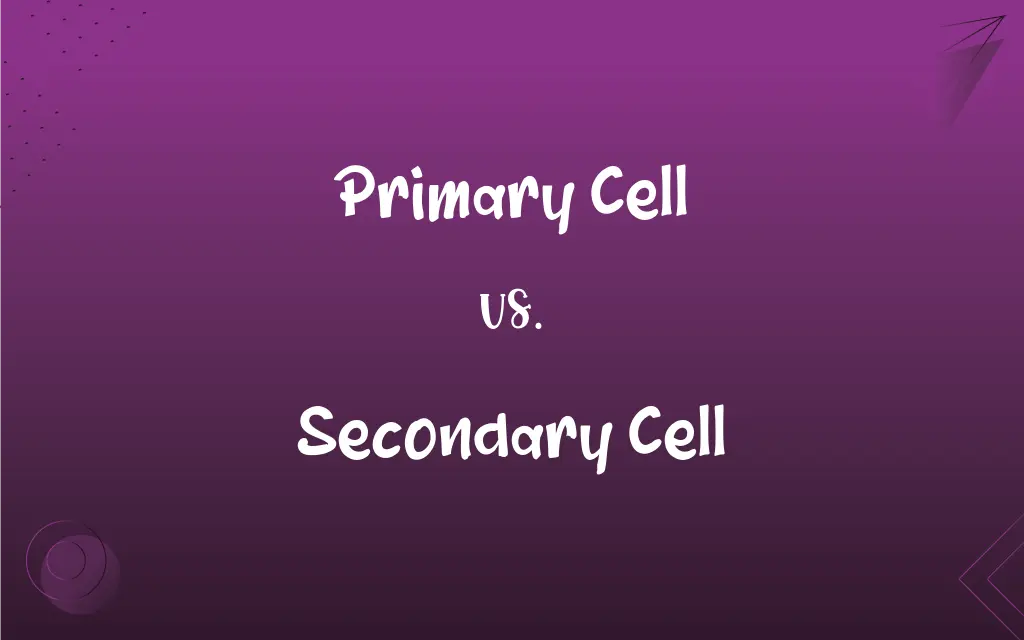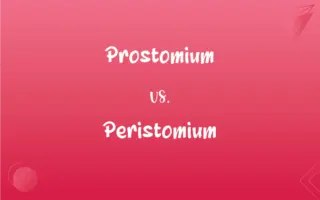Primary Cell vs. Secondary Cell: What's the Difference?
Edited by Aimie Carlson || By Harlon Moss || Updated on October 28, 2023
Primary cells are non-rechargeable batteries that are used once and discarded; secondary cells are rechargeable batteries used multiple times.

Key Differences
Primary cells and secondary cells serve as the backbone of our portable electronic age. The primary cell, once activated, cannot be recharged and is designed for single use. This means that after its energy is depleted, it's disposed of. Secondary cells, on the other hand, are designed for multiple uses. When their energy is drained, they can be recharged and used again.
The chemical reactions in primary cells are irreversible. For instance, in alkaline batteries, once the zinc and manganese dioxide have reacted, they cannot be returned to their original state. Secondary cells, like lithium-ion batteries, have reversible reactions, which allows the cell to restore its energy through charging.
Primary cells typically have a longer shelf life than secondary cells. They can be stored for an extended period without much loss of their initial energy. Secondary cells gradually lose their charge over time, even when not in use, due to self-discharge.
In terms of cost-effectiveness, primary cells might seem cheaper initially, but secondary cells offer long-term value because of their rechargeability. However, primary cells often deliver a consistent voltage throughout their lifespan, making them ideal for certain applications.
Both primary cells and secondary cells come with environmental concerns. Primary cells contribute to waste, as they are discarded after use. Secondary cells, while reusable, can pose threats if not disposed of or recycled properly due to the materials within them.
ADVERTISEMENT
Comparison Chart
Rechargeability
Non-rechargeable
Rechargeable
Usage
Single use
Multiple uses
Chemical Reactions
Irreversible
Reversible
Shelf Life
Typically longer
Shorter due to self-discharge
Cost Effectiveness
Cheaper initially, but not long-term
More expensive but reusable
ADVERTISEMENT
Primary Cell and Secondary Cell Definitions
Primary Cell
A cell with irreversible chemical reactions.
The chemical processes in a primary cell prevent it from being reused.
Secondary Cell
An energy storage device that requires periodic recharging to maintain its efficiency.
My electric car uses secondary cells, so I need to charge it regularly.
Primary Cell
A battery that is designed for one-time use and cannot be recharged.
I replaced the primary cell in my flashlight because it ran out of power.
Secondary Cell
A cell with chemical reactions that can be reversed.
The advantage of a secondary cell is its ability to undergo reversible reactions.
Primary Cell
An energy storage device discarded after its energy is exhausted.
After the toy stopped working, I knew the primary cell was spent.
Secondary Cell
A power source that can be restored to its full capacity after use.
When my phone died, I recharged the secondary cell to use it again.
Primary Cell
A battery that offers a longer shelf life due to its non-rechargeable nature.
I store primary cells for emergencies since they have a long shelf life.
Secondary Cell
A battery that may suffer from self-discharge over time.
Even if not used, the secondary cell in my drill loses charge over time.
Primary Cell
A power source that maintains a steady voltage until depleted.
The primary cell in my remote provided consistent performance until it died.
Secondary Cell
A battery that can be recharged and used multiple times.
I saved money using a secondary cell for my camera, as I could recharge it.
FAQs
Can secondary cells be used repeatedly?
Yes, secondary cells are rechargeable and designed for multiple uses.
What is the primary use of a primary cell?
Primary cells are for one-time use and cannot be recharged.
Is there an environmental concern with primary cells?
Yes, primary cells contribute to waste as they are discarded after use.
What advantage does a secondary cell have over primary cells?
Secondary cells can be recharged and used multiple times, offering long-term value.
How do secondary cells contribute to sustainability?
Secondary cells reduce waste by being rechargeable, lessening the need for constant production and disposal of batteries.
Are the reactions in primary cells reversible?
No, primary cells have irreversible chemical reactions.
Do primary cells have a higher initial voltage than secondary cells?
Generally, primary cells can have a slightly higher initial voltage, but it depends on the specific chemistry of the cells in question.
Which cell type is more environmentally friendly?
Secondary cells are more environmentally friendly in the long run due to their rechargeability, but proper recycling and disposal are crucial for both cell types.
What makes the chemical reactions in primary cells irreversible?
The materials used in primary cells, like zinc and manganese dioxide, react in a manner that can't be reversed.
Why do secondary cells lose charge even when not in use?
Secondary cells undergo self-discharge over time, reducing their stored energy.
How do we prolong the life of secondary cells?
By ensuring proper charging habits, avoiding overcharging, and storing in moderate temperatures.
How many times can a secondary cell be recharged?
While it varies by type and quality, many secondary cells can be recharged hundreds or even thousands of times.
How often do secondary cells need to be replaced?
Secondary cells have a longer lifespan due to their rechargeability but still need eventual replacement.
Which cell type is more cost-effective over time?
Secondary cells are more cost-effective in the long run due to their rechargeability.
Are there safety concerns with secondary cells?
Yes, if improperly handled or damaged, secondary cells can pose risks like overheating or fire.
Can primary cells be recycled?
Yes, many primary cells can be recycled, but specific disposal methods vary based on cell composition.
What's a common example of a device using secondary cells?
Mobile phones commonly use secondary cells as their batteries.
Can primary cells be used after a long period of storage?
Yes, primary cells typically have a longer shelf life and can be used after extended storage.
Which cell type is ideal for devices requiring consistent voltage?
Primary cells are ideal as they deliver consistent voltage throughout their lifespan.
Is there any risk in disposing of primary cells in regular trash?
Yes, due to chemicals and metals in them, it's advised to recycle primary cells or dispose of them as hazardous waste.
About Author
Written by
Harlon MossHarlon is a seasoned quality moderator and accomplished content writer for Difference Wiki. An alumnus of the prestigious University of California, he earned his degree in Computer Science. Leveraging his academic background, Harlon brings a meticulous and informed perspective to his work, ensuring content accuracy and excellence.
Edited by
Aimie CarlsonAimie Carlson, holding a master's degree in English literature, is a fervent English language enthusiast. She lends her writing talents to Difference Wiki, a prominent website that specializes in comparisons, offering readers insightful analyses that both captivate and inform.































































